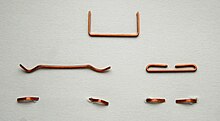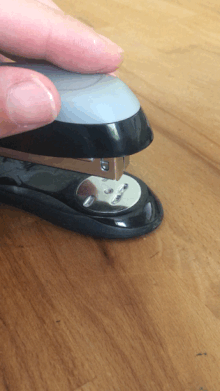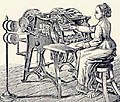Staple
A staple is a piece of metal that is bent into a U-shape and is inserted into the materials to be joined by means of a stapler . Usually the ends are bent over. Staples are usually made of copper-plated or galvanized steel , but also of aluminum or, more rarely, brass . A common application is the paper clip, which creates a permanent connection between two or more sheets of paper or the like. In contrast, a detachable connection can be achieved with a paper clip .
Executions
Staples for office staplers
Staples come in different designs and sizes, e.g. B. as 24/6 , 26/6 , 26/8 , 23/6 for approx. 30, 23/8 for approx. 50, 23/10 for approx. 70 and 23/13 for approx. 100 sheets, as well as in a few millimeters in size. Only the 24/6 version was standardized . The withdrawn DIN 7405 ("Staple 24/6 for office staplers; staples, staples") from December 1963, which replaced the previous standard from December 1942, regulated the dimensions, design, designation, packaging and order designation. For example, only boxes with 1000 staples complied with this standard; other pack sizes were not intended. The clamps also had to be grouped together in clamp bars with 50 (± 1 tolerance) pieces each and glued.
The term 24/6 means that for the production of the staple of wire No. 24 according to the. German stitching wire teaching to use is (the smaller the number, the stronger the wire), and the staple a leg length of 6 mm (- 0.2 mm tolerance ) Has. A standardization of other versions was originally planned, but has not yet been implemented.
| Type | width | Height (leg length) | Wide wire | Thick wire |
|---|---|---|---|---|
| 24/6 (No. 3) | (11.7-) 12.8 | 6th | 0.69-0.7 | 0.37-0.5 |
| 26/6 (also 66/6 or No. 56) | 12.7-12.8 | 6th | 0.5 | 0.4 |
| 10/5 (No. 10) | (8.4–) 9 (0.354 ″) | 4.8–5 (3/16 ″) | 0.5 | |
| 6/4 (No. 8; e.g. Zenith) | 5.8-6 | 4 (5/32 ″) | 0.5 | |
| Leitz / Rapid / Elastic Jewel, Novus 111 / B35 | 6.8-7 | 3.8-4 | 0.64-0.7 | 0.4 |
The number after the slash indicates the height of the bracket. The staples are often available in various lengths (up to about 18 mm).
Staples always have a flattened cross-section, made of galvanized or copper-plated steel wire, but can also be made of aluminum (for tea bags) or stainless steel.
Staples with eyelets , actually U-shaped bulges, are sometimes used to staple staples . These are called ring eyelet staples or ring clips and require special setting tools. Two or four clips at the correct distance in the spine fold of a booklet allow filing in the folder .
The thinner, more flexible thread stitching is important in bookbinding . A household sewing machine can also help sew the thread and position the fold through the perforation.
Some staples also fit in staplers, i.e. staplers for applications in the construction sector.
Staples
In general, staples are made of stronger wire than staples. They are mostly available in lengths of 4 to 30 mm for mechanical and simple electrical devices. Professional devices are available for staples and nails in almost every imaginable size.
| Type | Back width | Wide wire | Thick wire | z. B. for devices from |
|---|---|---|---|---|
| 37 | 10.6 | 0.8 | 0.5 | ACE, FixFast, Lux, Maestri, Maxicraft, Novus, Prebena, Rapesco, Rapid, Rexel, Rocafix, Technica, Würth |
| 050 | 10.8 | 1.25 | Arrow, B&D , Drapper, Ernhart, Esco, Haubold, Lux, Mekano, Novus, Outifrance, Peugeot, Rapid, Rawlplug, Rocafix, Stanley | |
| No. 50 or D | 12.7 | 1.25 | 0.55 | ACE, BeA, Bostich, Duo-Fast, Fasco, Haubold, Kiehlberg, Rocama, Senco, SpotNails |
| 052 | 12.3 | 1.2 | 0.5 | B&D |
| 053 | 11.4 | 0.7 (- 0.75) | 0.6 | ACE, AEG, Arrow, B&D , Bosch, Ernhart, Esco, Fischer, Kunz, kwb, Metabo, Mekano, Neckermann / Bullcraft, Novus, Proxxon, Rapid, Rocagraf, Skandia, Wolfcraft, Piranha, Stanley |
| 055 | 6th | 1.08 | ACE, AEG, B&D, Bosch, Bukama, Esco, HolzHer, kwb, Lux, Metabo, Neckermann / Bullcraft, Novus, Petrus, Wolfcraft | |
| 057 | 10.6 | 1.25 | 0.5 | ACE, Arrow, B&D , Bosch, Bostich, Esco, kwb, Maestri, Mekano, Novus, Outifrance, Peugeot, Rapid, Rocafix |
| 058 | 13 | 0.75 | Arrow (T30, TN 30, T32, T32 M), Bostich (TGD, TGA, Regal T), Esco (Type 58, Type 58 N), kwb (T6, T40, PN14 N), Lux (Profi-Tacker, Multi -Tacker), Novus (J03, J06, J08, J15 J58Trig), Rexel (Lo-Line), Rocagraf, Swingline, Skrebba, Stanley (Hobby 8, Pro 8) | |
| 059 | 10.6 | 0.72 | Rapid, Rocagraf | |
| 073 | 11.3 | 1.3 | 0.5 | ACE, Arrow, Dr. Gold, Novus, Rapid |
| 090 | 5.5 | 1.25 | 1.05 | ACE, BeA, Duo-Fast, Fasco, Haubold, Kiehlberg, Prebena, Senco, SpotNails |
The back width denotes the outside dimension of the clamps. To get the inside dimension , you have to subtract twice the wire thickness .
Depending on the manufacturer, the type of bracket is specified with two or three digits. The first zero is left out of the two-digit designation.
| designation | Staple back | For tackers | use |
|---|---|---|---|
| Fine wire clips | very small | Hand, electric, battery, compressed air and hammer tacker | Decoration and upholstery work |
| Flat wire staples | wide and flat | Hand, electric, compressed air and hammer tackers | Attachment of foils |
| Narrow back staples | short | Electric tacker with a long nose | Wood and interior work |
| Cable clips | round | special staplers | Cable fastening |
| Type | Head width | Wide wire | Thick wire | z. B. for devices from | typical lengths |
|---|---|---|---|---|---|
| A64 | 0.9 | 0.6 | 0.6 | BeA, Bostich, Fasco, Haubold, HolzHer, Kihlberg, Prebena, Senco, SpotNails | |
| 41 | 0.85 | 0.85 | 0.7 | Bosch HT14, Esco Rallye S 530 / Compacta 530 / C 530 / N 530, Kwb T14 | 14th |
| 47 or J | 1.8 | 1.2 | 1 | ACE, AEG, Bosch, Esco (Craftomat), Kwb, Lux, Mekano, Metabo, Novus, Peugeot, Rocafix, Rocagraf, Stanley, Swingline, Wolfcraft | 16-23 |
| 049 or FN | 2.8 | 1.6 - 1.65 | 1.4 | ACE, BeA, Black & Decker , Bostich, Fasco, Haubold, HolzHer, Kihlberg, Prebena, Senco | 16-30 |
| 062 or GN | 2 - 2.1 | 1.2-1.25 | ACE, AEG, BeA, Bosch, Bostich, Esco (Craftomat), Fasco, Haubold, HolzHer, Kihlberg, Kwb, Maestri, Metabo, Novus, Prebena, Rapid, Senco, Swingline, Wolfcraft |
Wire thickness is also called wire thickness and means the thickness of the wire parallel to the back of the staple or to the head of the staple nail .
The wire width is measured across the back or head. In addition to the width of the clamp , the wire width is decisive for the correct function of the device. Only a few special staple guns per se can cope with different wire widths or can be set to two different widths.
Tools
Stapler and staple remover
The staples are used in a stapler to staple multiple sheets of paper together. In the German area the stapler is colloquially often called Tacker or spider monkey called. Proper names are in Austria stapler , Switzerland Bostitch (after the US manufacturer Bostitch - originally "Boston Wire Stitcher"). The punch of the stapler first pushes the two legs of the staple through the paper until they meet guides in the foot ( anvil ) of the device, from which they are bent. In addition to the classic stapler, which is often used in offices, there are flat staplers, block staplers, super staplers, electric staplers and even stapling pliers that are also intended to staple paper. The main difference with these staplers lies in the use of the lever , and another in the amount of paper that can be stapled with it.
A distinction is made between closed and open stapling: in the former, the legs are bent inwards, in the latter outwards, which makes it easier to separate the sheets if necessary. With many commercially available staplers, you can switch between these modes by sliding or rotating the staple guide plate in the anvil of the stapler. Most of the time, however, closed stapling is used, and some simple stapler models only master this mode.
With a little skill, a staple can be bent open by hand and the connection can be released again. A staple remover is a device that makes this tedious work easier and can loosen the staple again. However, when removed, two holes are left in each sheet. Another disadvantage of staples is that they can rust over time, which can discolor the paper. This poses a considerable problem for archives , since naturally large quantities of written material have to be processed here, which means that a great deal of effort is required to remove all of the staples.
Stapler
Staples are also used in the craft for stapling materials. Stapling machines for this purpose are constructed very differently:
In a tacker sometimes, Nagler called, a spring is tensioned by hand lever, which then suggests in triggering by means of a knock pin to a single staple, which is then attached a pad material to a (thicker) pad. A staple holds a staple in a firm and sufficiently thick (should be thicker than the length of the staple legs ) material (usually wood ), similar to a nail , even without bending.
Staples are hammered in with a swing with a hammer . These devices are operated like a hammer .
Electric tackers and compressed air-operated ( pneumatic ) tackers develop greater forces than manual staplers : They shoot appropriate staples or nails with great force into the respective substrate, e.g. B. for fastening upholstery materials, insulation boards, profile boards and floorboards .
Many staplers have a "feeler nose" / "impact protection" at the staple exit point as a safety feature. It only releases when the tacker is pressed onto the surface with a certain amount of force. This is to avoid the dangerous "shooting" of clips. The driving depth of almost every stapler can be adjusted and thus adapted to the material and staple height, e.g. using a knurled screw . The impact strength can be adjusted via the air pressure delivered on the compressor. Some staplers can also drive nails in a row, cf. Pneumatic nailer .
Wire stitching machines
So-called wire stitching machines are used in the printing industry for final production and in mass production . These machines automatically bend a staple of the correct length from wire (diameter about 0.5 mm) that is provided on a roll, push it through the paper and bend the ends not slightly bent, but flat (flat clinch) so that the finished stapled documents can be stacked to save space.
Surgical device
To close skin wounds, metal staples are used that hold the skin together from the outside. Clamps can also be used inside the body, but these are usually not set individually, but stapling devices are used.
history
The first surviving stapler was a stapling machine or a fastener from King Louis XV. of France around 1700. Each staple was hand made and labeled with the badge of the royal court.
Modern paper fastening devices are more like the model of Samuel Slocum's device protected by a patent on September 30, 1841 . This simple device fastened needles in paper to sew it together.
On August 7, 1866, another new paper stapler was patented by the Novelty Mfg Company . It made it possible to load a single staple, mainly to bind books or to fix carpets, furniture or boxes. Staples for this device are manufactured by the PN Mfg Co. in various sizes: 3/16 inch , ¼ inch, ⅜ inch and ½ inch.
George W. McGill received US patent 56,587 on July 24, 1866 for a small, flexible, machine-made staple, the predecessor of the modern staple. On August 13, 1867, he finally received US patent 67,665 for a "press" with which the staples could be pressed into the paper. He showed his invention at the Philadelphia Centennial Exhibition in 1876 . Over the next few years, McGill developed the paper stapler further. On February 18, 1879, he was finally granted patent no. Awarded 212,316 for a single stapler. This device weighed over a kilogram and could push a single 1/2 inch wide wire staple through multiple sheets of paper.
However, his competitor Henry Heyl immediately patented a lighter, everyday device and is therefore sometimes considered an inventor.
The wire stitching machine was invented by Hugo Brehmer in America, but only brought to perfection by his brother August Brehmer and patented in 1872. The first book stapled with wire was the official catalog for the World's Fair in Philadelphia (PA) in 1876.
The small, functionally designed 24/6 stapling machine “Frog” by Sax was widely used in Austria from 1970 to 1990 : Made of sheet steel, chrome-plated, base and cap, however, painted in color, on each side a viewing hole reminiscent of frog eyes.
Alternatives
A few sheets of paper can be stapled together even without wire.
- Special staple staplers ("eco staplers") punch a tongue in the sheets, fold it in the opposite direction and push this tongue back into a slot. This is done with a single pressing process . The advantage is the low application thickness and the saved weight. This makes it possible to send stapled sheets with airmail without additional weight. This stapling is also detachable, but further manual stapling without tools is hardly or only poorly possible. In Japan in particular, such staple-less staplers also exist with a different mode of operation, in which several sheets are interlocked with one another under pressure via an embossing mechanism.
- Corner clips are placed on one corner of the stack of sheets (here, for example, with eight sheets), folded around the edge and finally folded back with the sheets.
Web links
- McGill's Staple Press (U.S. Patent 67,665 ) at Google Patents.
- McGill's staple device (US Patent 212,316 ) at Google Patents.
Individual evidence
- ↑ a b c d e f g h i j k Dimensions from Margreiter Technik and Hans Hilscher GmbH; accessed in December 2016
- ↑ Studies on everyday German, accessed on April 25, 2012 .
- ↑ Stapler lever graphic ( Memento from May 22, 2014 in the Internet Archive ), accessed on June 10, 2014.
- ↑ a b c jjev: The inventor of the stapler - flashes of inspiration: Tack Tack! . In: badische-zeitung.de, opinion, Geistesblitze , February 18, 2012 (February 19, 2012).














